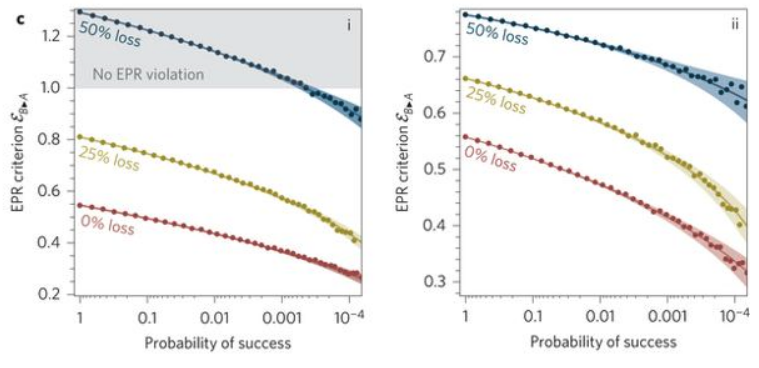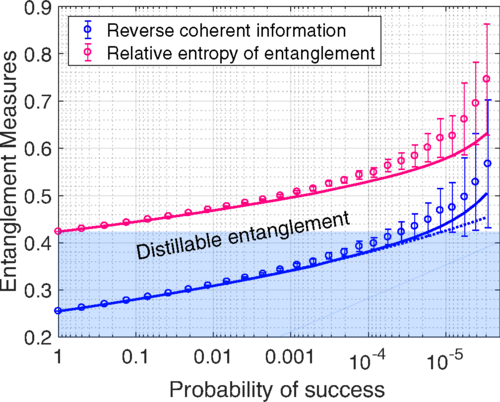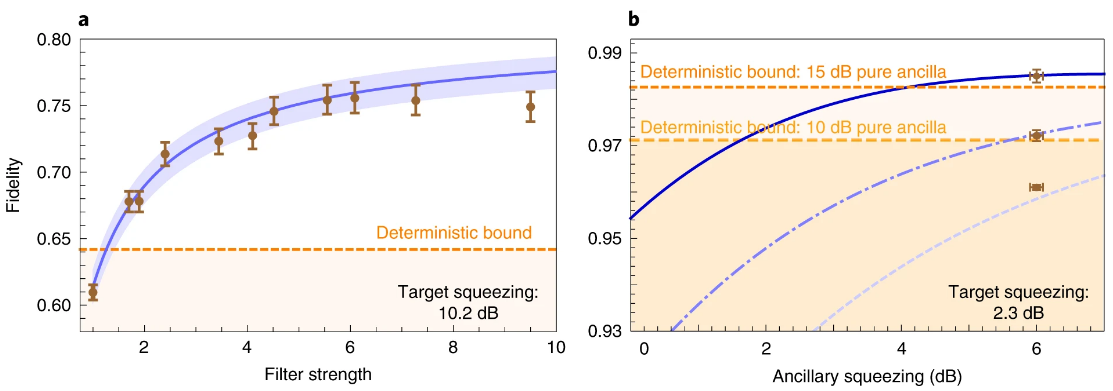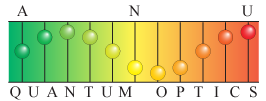The fidelity of continuous variable (CV) protocols are limited by the initial resource. In a series of works, the ANU quantum optics group demonstrated that the fidelities of CV protocols can be improved by resorting to probabilistic operations. These operations are heralded allowing us to keep the results only when the operation is successful.
Measurement based entanglement distillation

In 2013, Nathan Walk introduced a Gaussian post-selection protocol for CV quantum key distribution by linking the Gaussian post-selection to a noiseless linear amplifier (NLA) [1]. In 2014, Helen Chrzanowski used a measurement-based noiseless linear amplification (MB-NLA) to demonstrate entanglement distillation of the post-selected data [2]. It was shown that this can extend the secure communication distance for quantum key distribution.
Measurement based noiseless linear amplifier for quantum cloning
In 2016, Jing Yan Haw embedded the MB-NLA in a quantum amplifier to probabilistically clone coherent states with fidelity greater than the deterministic limit [3]. We produce up to five clones. You can read more about it from our press release. There is also a video explaining the principle behind the protocol. In 2017, Jie Zhao performed a theoretical study to compare the MB-NLA with a physical NLA, looking at their probability of success and output fidelity with varying gains and input coherent states [4]. In the same year, Syed Assad used the quantum Cramer-Rao bound to look at using the NLA to perform phase estimation of coherent states [5]. In some regime where the cost of performing an estimation is expensive, the NLA will over an advantage over a direct estimation. Also in 2017, Jie Zhao used the MB-NLA to experimentally enhance the SNR of a quantum linear amplifier [6].
Entanglement properties of the measurement based noiseless linear amplifier

In 2019, Hao Jeng studied the entanglement properties of the MB-NLA distillation experiment using various different measures of entanglement [7]. An increase in the distillable entanglement was verified for the first time.
High-fidelity heralded squeezing gate

In 2020, Zhao Jie with Liu Kui from Shanxi University demonstrated a high-fidelity squeezing gate by using a heralded post-selection protocol [8] . A squeezing gate uses an anciliary vacuum state to squeeze an arbitrary state. However the fidelity of existing implementations is ultimately limited due to the limited anciliary squzeeing. This heralded squeezing gate can overcome this and allows improved gate fidelity without requiring more squeezed ancillary vacuum. Read more about it in ANU's press release and CQT highlights.
References
[1] N. Walk, T. C. Ralph, T. Symul, and P. K. Lam, “Security of continuous-variable quantum cryptography with Gaussian postselection,” Phys. Rev. A, vol. 87, no. 2, p. 020303, 2013.
[2] H. M. Chrzanowski et al., “Measurement-based noiseless linear amplification for quantum communication,” Nature Photonics, vol. 8, no. 4, p. 333, 2014.
[3] J. Y. Haw et al., “Surpassing the no-cloning limit with a heralded hybrid linear amplifier for coherent states,” Nature communications, vol. 7, p. 13222, 2016.
[4] J. Zhao, J. Y. Haw, T. Symul, P. K. Lam, and S. M. Assad, “Characterization of a measurement-based noiseless linear amplifier and its applications,” Physical Review A, vol. 96, no. 1, p. 012319, 2017.
[5] S. M. Assad, M. Bradshaw, and P. K. Lam, “Phase estimation of coherent states with a noiseless linear amplifier,” International Journal of Quantum Information, vol. 15, no. 1, p. 1750009, 2017.
[6] J. Zhao et al., “Quantum enhancement of signal-to-noise ratio with a heralded linear amplifier,” Optica, vol. 4, no. 11, pp. 1421–1428, 2017.
[7] H. Jeng et al., “Entanglement properties of a measurement-based entanglement distillation experiment,” Physical Review A, vol. 99, no. 4, p. 042304, 2019.
[8] J. Zhao, et al., “A high-fidelity heralded quantum squeezing gate,” Nature Photonics pp. 1-4, 2020.
